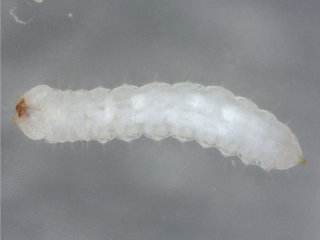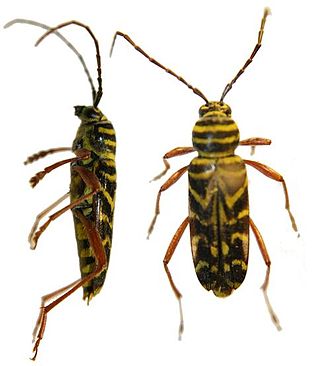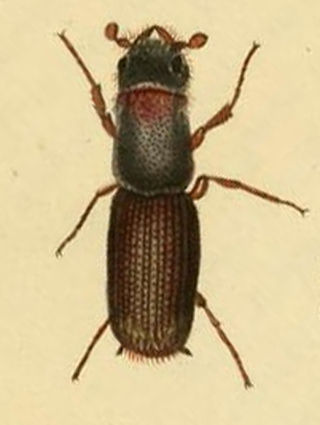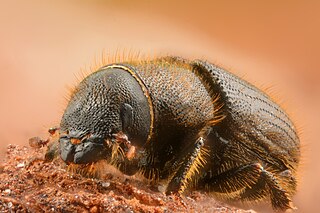Related Research Articles

The telephone-pole beetle is a beetle native to the eastern United States and the only living representative of the otherwise extinct family Micromalthidae. Larvae of the beetle live in decaying wood and can be pests to wooden structures, lending them their common name, the 'telephone-pole beetle.'

The deathwatch beetle is a species of woodboring beetle that sometimes infests the structural timbers of old buildings. The adult beetle is brown and measures on average 7 mm (0.3 in) long. Eggs are laid in dark crevices in old wood inside buildings, trees, and inside tunnels left behind by previous larvae. The larvae bore into the timber, feeding for up to ten years before pupating, and later emerging from the wood as adult beetles. Timber that has been damp and is affected by fungal decay is soft enough for the larvae to chew through. They obtain nourishment by using enzymes present in their gut to digest the cellulose and hemicellulose in the wood.

The Lymexylidae, also known as ship-timber beetles, are a family of wood-boring beetles. Lymexylidae belong to the suborder Polyphaga and are the sole member of the superfamily Lymexyloidea.

Aethina tumida,commonly known as small hive beetle (SHB), is a beekeeping pest. It is native to sub-Saharan Africa, but has spread to many other regions, including North America, Australia, and the Philippines.

Rhizophora is a genus of tropical mangrove trees, sometimes collectively called true mangroves. The most notable species is the red mangrove but some other species and a few natural hybrids are known. Rhizophora species generally live in intertidal zones which are inundated daily by the ocean. They exhibit a number of adaptations to this environment, including pneumatophores that elevate the plants above the water and allow them to respire oxygen even while their lower roots are submerged and a cytological molecular "pump" mechanism that allows them to remove excess salts from their cells. The generic name is derived from the Greek words ριζα (rhiza), meaning "root," and φορος (phoros), meaning "bearing," referring to the stilt-roots.

The wharf borer, Nacerdes melanura, belongs to the insect order Coleoptera, the beetles. They belong to the family Oedemeridae, known as false blister beetles. Wharf borers are present in all the states of the USA except for Florida. It takes about a year to develop from an egg to an adult. The name 'wharf borer' comes from the larval stage of this insect, which often lingers on pilings and timbers of wharves, especially along coastal areas. The adult beetles are identifiable via a black band across the end of both elytra. In addition, wharf borers are distinct from other members of the family Oedemeridae due to the presence of a single spur on the tibia of the forelegs and the distance between both eyes. The female beetle oviposits eggs on rotten wood, on which the larvae hatch, burrow, then feed. Adults do not eat and depend on stored energy reserves accumulated as a larva. They are considered a pest because they damage wood used in building infrastructures.

Megacyllene robiniae, commonly known as the locust borer, is a species of longhorn beetle endemic to eastern North America. It is a serious pest of Robinia pseudoacacia, the black locust tree, with which it is sympatric.

Chauliognathus is a genus of soldier beetles in the family Cantharidae. Adults have almost rectangular bodies. Some are red and black, similar to the military uniforms that were common before the usage of camouflage, hence the name of soldier beetles. Others are orange and black. The elytra or first pair of wings are softer than the elytra of most beetles, that is why their other common name is leatherwings. The adults are frequently found on flowers, such as sunflowers, goldenrod, coneflowers, where they mate and feed on pollen and nectar. The larvae are more common in the ground or among debris, where they feed on eggs or larvae of other insects. The adults are most frequently found in summer and early fall. They are native to America and Australia.

Lyctus carbonarius is a wood-boring beetle in the family Bostrichidae, commonly known as the southern lyctus beetle or lyctid powderpost beetle. It is a serious pest of hardwoods including ash, hickory, oak, maple and mahogany and can infest many products in the home including hardwood flooring and structural timbers, plywood, furniture, tool handles, picture frames, baskets and ladders. Timber can be infested in one location and then be transported large distances by ship, after which the beetles can emerge and spread the infestation to new areas.

Hylobius transversovittatus is a species of weevil in the family Curculionidae. It is native to the Old World where both adults and larvae feed on purple loosestrife. This plant is regarded as an invasive species in North America and the weevil has been introduced into both the United States and Canada in an effort to control the plant.

Platypus apicalis, known by its common name the New Zealand pinhole boring beetle, is a wood-boring beetle endemic to New Zealand and found throughout the North and South Island in a range of environments.

Xylosandrus compactus is a species of ambrosia beetle. Common names for this beetle include black twig borer, black coffee borer, black coffee twig borer and tea stem borer. The adult beetle is dark brown or black and inconspicuous; it bores into a twig of a host plant and lays its eggs, and the larvae create further tunnels through the plant tissues. These beetles are agricultural pests that damage the shoots of such crops as coffee, tea, cocoa and avocado.

Platypus cylindrus, commonly known as the oak pinhole borer, is a species of ambrosia beetle in the weevil family Scolytinae. The adults and larvae burrow under the bark of mature oak trees. It is native to Europe.

Dendroctonus micans, the great spruce bark beetle, is a species of bark beetle native to the coniferous forests of Europe and Asia. The beetles burrow into the bark of spruce trees and lay eggs which develop into larvae that feed on the woody layers under the bark.

Dendroctonus terebrans, the black turpentine beetle, is a species of bark beetle native to the eastern United States. Its larvae tunnel under the bark of pine trees, weakening and sometimes killing the trees.
Xyloterinus is a genus of typical bark beetles in the family Curculionidae. This is a monotypic genus and the one described species is Xyloterinus politus. It is native to North America where it infests both hardwood and softwood trees, as well as stacks of logs.

Dendroctonus adjunctus, the roundheaded pine beetle, is a species of bark beetle in the family Curculionidae found in North America. A parasite, the roundheaded pine beetle feeds on and eventually kills pine trees of several species in Guatemala, Mexico, and the Southern United States.

Euoniticellus intermedius is a species of dung beetle in the family Scarabaeidae. E. intermedius is native to Southeastern Africa but has spread to the United States, Mexico, and Australia. E. intermedius acts as an important agricultural agent due to its improvement of soil quality and removal of parasitic pests.
Euplatypus parallelus, previously known as Platypus parallelus, is a species of ambrosia beetle in the weevil family Curculionidae. The adults and larvae form galleries in various species of tree and logs. It is native to Central and South America but has spread globally, is present in Africa and is well established in tropical Asia.
Xyleborus perforans, commonly known as island pinhole borer, is a species of weevil native in the Oriental region through to Australia but shows a cosmopolitan distribution due to introduction to many parts of the world.